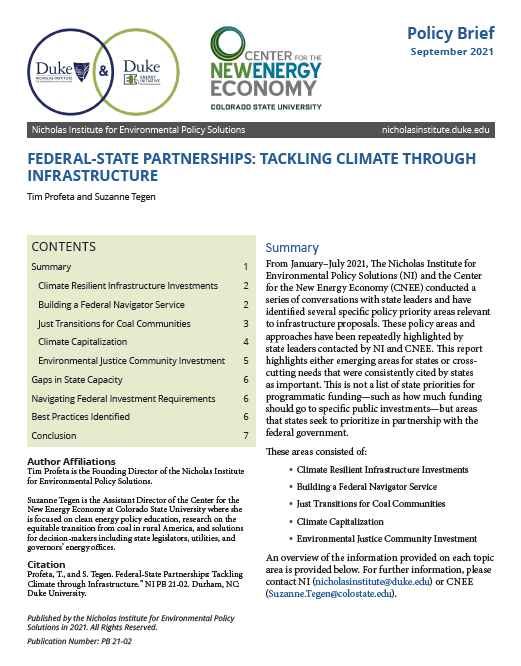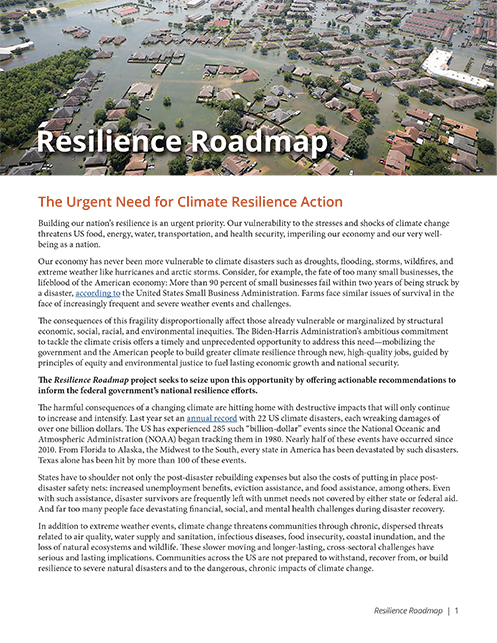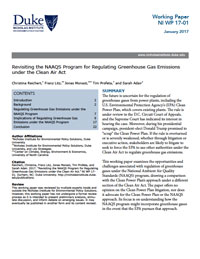Publications
Projecting Electricity-Sector Investments Under the Inflation Reduction Act: New Cost Assumptions and Interactions with EPA’s Greenhouse Gas Proposal
Energy Pathways USA, an initiative of the Nicholas Institute for Energy, Environment & Sustainability at Duke University, has released a report that offers new insights into US energy transition investments. This report comprehensively models the intersecting effects of the Inflation Reduction Act, clean electricity development cost increases, and the impacts of proposed US Environmental Protection Agency greenhouse gas regulations for fossil fuels.
Federal-State Partnerships: Tackling Climate through Infrastructure
This report by the Nicholas Institute and the Center for the New Energy Economy highlights several specific policy priority areas relevant to infrastructure proposals in regards to climate issues.
Resilience Roadmap: The Urgent Need for Climate Resilience Action
Building our nation’s resilience is an urgent priority. Our vulnerability to the stresses and shocks of climate change threatens US food, energy, water, transportation, and health security, imperiling our economy and our very well-being as a nation. The Resilience Roadmap project seeks to offer actionable recommendations to inform the federal government’s national resilience efforts.
Climate Change Is Here, but Who Is Paying for It?
State and local governments have advanced their own initiatives on climate change when faced with a failure of federal leadership. This analysis looks at the challenge of costs to states in mitigating and developing resiliency to climate change.
Federal Grants to States: Opportunities for Climate Change Assessment, Planning, Programs, and Information Exchange
The lessons we learn from the mobilization in response to the COVID disaster should be applied as we prepare for another disaster that is putting increasing demands on state and federal resources: climate change. With states and the federal government all having essential roles to fulfill in the response to national disasters, an effective federal-state partnership should be at the heart of a nationwide climate strategy.
Testimony Before the Subcommittee on Environment & Climate Change of the U.S. House Committee on Energy & Commerce
Nicholas Institute Executive Director Tim Profeta testifies before the Subcommittee on Environment & Climate Change of the U.S. House Committee on Energy & Commerce to suggest the best means by which to achieve economy-wide solutions to climate change. The central point of his testimony is that Congress should strongly consider a model that has been successfully proven through our nation’s history: the federal/state partnership.
Using the Old to Solve the New—Creating a Federal/State Partnership to Fight Climate Change
This policy brief proposes that there may be another way to solve the failure of federal solutions to fight climate change. Instead of attempting to settle all concerns about a program’s costs and impacts at the federal level, simply let Congress determine the level of ambition needed to achieve our climate goals. And then use the state governments, which are more in touch with the equitable tradeoffs of their populations and directly accountable to their communities, to execute plans to reach those goals.
Revisiting the NAAQS Program for Regulating Greenhouse Gas Emissions under the Clean Air Act
The future is uncertain for the regulation of greenhouse gases from power plants, including the U.S. Environmental Protection Agency’s (EPA) Clean Power Plan, which covers existing plants. The rule is under review in the D.C. Circuit Court of Appeals. If the rule is overturned or is severely weakened, whether through litigation or executive action, stakeholders are likely to litigate to seek to force the EPA to use other authorities under the Clean Air Act to regulate greenhouse gas emissions. This working paper examines the opportunities and challenges associated with regulation of greenhouse gases under the National Ambient Air Quality Standards (NAAQS) program, drawing a comparison with the Clean Power Plan’s approach under a different section of the Clean Air Act.
Enhancing Compliance Flexibility under the Clean Power Plan: A Common Elements Approach to Capturing Low-Cost Emissions Reductions
As states and stakeholders evaluate compliance options under the U.S. Environmental Protection Agency’s proposed Clean Power Plan, many recognize the potential economic benefits of market-based strategies. In some states, however, market approaches trigger administrative and political hurdles. A new policy brief by the Nicholas Institute for Environmental Policy Solutions offers a compliance pathway that allows states to realize the advantages of multistate and market-based solutions without mandating either strategy. With the common elements approach, states develop individual-state plans to achieve their unique emissions targets and give power plant owners the option to participate in cross-state emissions markets. Power plant owners can transfer low-cost emissions reductions between states whose compliance plans share common elements--credits defined the same way and mechanisms to protect against double counting. The common elements approach offers the following benefits: (1) allows cross-state credit transfers without states negotiating a formal regional trading scheme, (2) leaves compliance choices to power companies, (3) builds on existing state and federal trading programs, and (4) maintains the traditional roles of state energy and environmental regulators.
Author(s): Jonas Monast, Tim Profeta, Jeremy Tarr, and Brian Murray
Assessing Carbon-Pricing Policy Options in the United States
Much of the focus of efforts to reduce greenhouse gas emissions has been on the pursuit of policy mechanisms that will put a price on carbon. In the United States, such mechanisms have been established in several states and were the central feature of federal legislative proposals of the last decade. With the political failure of those proposals in 2009-2010, creation of a de novo carbon-pricing regime was given little attention—until recently. Calls for fiscal reform and an evolving regulatory setting (especially use of the Clean Air Act to regulate greenhouse gases) might create political appetite for a new effort to pursue a carbon-pricing policy. To inform discussion, this paper identifies and assesses options for establishing a price on carbon in the United States.










